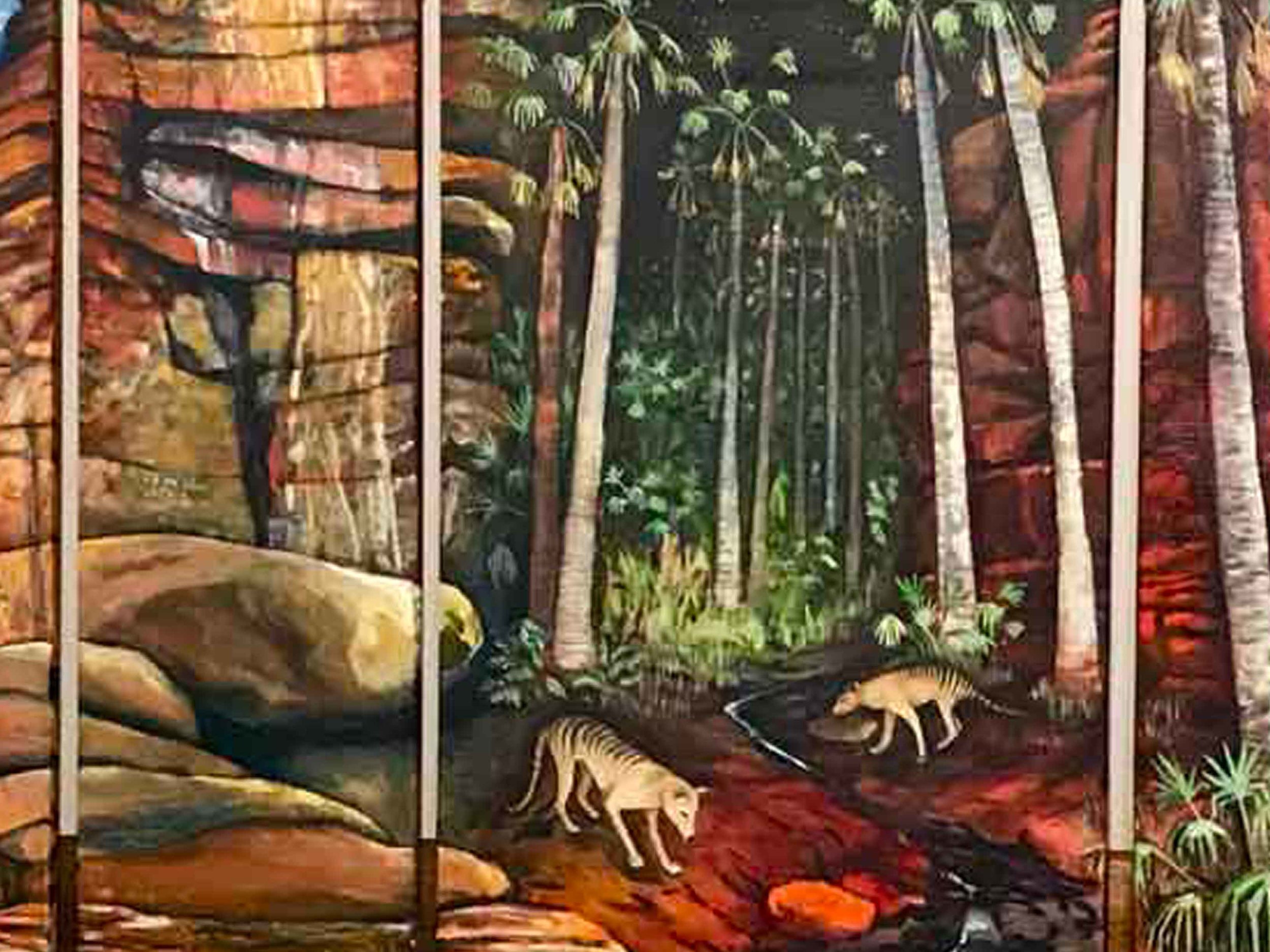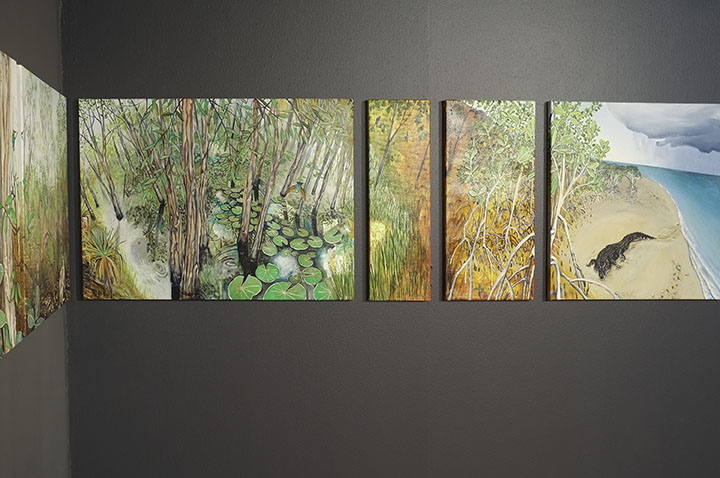
Painted in 2016 while doing a residency at the Territory Wildlife Park, this painting aims to take the viewer on a journey. It starts at the beginning of time, and quickly traverses thousands of years (from the ice age through to a sighting of the first fleet), seasons and night and day. It is based on this continent now known as Australia, and starts off with the formation of this planet as part of our galaxy. It took millions of years and underwent much transformation and eventually life forms developed. In the painting I have included the Stromolites (micro bacterial rock created by Cyanobacteria and seen as examples of the earliest form of life) and the recently found dinosaur footprints of WA (up to 1.5 m long and dated from 130 million years ago). Yawuru, the Traditional Custodians of the area have had strong cultural connections with these footprints for thousands of years and woven these footprints into their local mythologies.
The Wolf Creek meteorite crater has been included. Known as Kandimalal by the Djaru clan. Probably formed 120,000 years ago and a significant part of many Dara “Dreaming” stories. One describes the crater’s round shape being formed by the passage of a rainbow snake out of the earth. Another story makes reference to a crescent moon passing a star so closely that it became so hot it fell to the earth and caused an explosion that scared the local people for a long time afterwards.
Mega fauna such as the leaf eating Diprotodon were common in Southern Australian but in 2013, a skeleton was found near Katherine, NT. Appearing in Australia about 25 million years ago it co-existed with aboriginal people for over 20,000 years, becoming extinct about 25,000 years ago. Aboriginal people arriving at least 45,000years ago.
Aboriginal art of northern Australia reflects the changes in the environment. 20,000 the climate cooled dramatically and the aboriginal people had to move. There was an ice age and much of Australia was uninhabitable and so aboriginal clans consolidated into areas around water and food. The Climate was dryer and the sea level was 150 meters lower than present. The rock art showed naturalistic portrayals of humans and animals, some now extinct. 15,000 the climate became dryer and the rock art showed simple figures with headdresses and boomerangs. 10,000 years ago, the sea levels started to rise and the climate became wetter. The Aboriginal people adjusted and the painted figures are using spears to hunt. 6000 years ago, mangroves formed and then marine fish and then shell fish. X-ray fish appear in the ochre paintings on the rock. 2000 years ago, levee banks formed allowing freshwater flood plains, birds, turtles and file snakes. Magpie geese are now included in the art along hunters with goose spears. 150 years ago, Guns, sailing boats and Macassan knives are painted over and alongside the layered, important, visual knowledge of this continent.
The rock art in the Kimberly and Ubirr, show us that the Thylacine (Tasmanian Tiger) travelled down from Northern Australia eventually to Tasmania. It is thought it was hunted for food by aboriginal people. Fossils have been found in Queensland of thylacines dating from about 30 million years ago. The modern Thylacine mummified carcass has been found on the Nullarbor dated 4 to 5000 years ago. Becoming extinct on the mainland 2000 years ago, it was last documented alive in Tasmania in 1933.
We know from rock art and some later bark paintings that there were visitors to this continent well before 1788. In the 1400s Chinese sailors visited the top end and in 1450 Dutch documents record the trading between Macassan Trepangers and aboriginal communities. Rock paintings of 1600s show sailing boats and contemporary bark paintings have within their designs, stories of relationships between Macassan sailors and aboriginal women. We also know of the interaction through introduced species such as the Tamerine tree being found in remote locations and several aboriginal words being traced back to Malay (rupiah - money, jama - work, Bala day - white person). The Macassan traders came from Makassar, (Ujungpandang) to fish for Trepang (sea cucumber) and then processing it by boiling it with Mangrove bark and drying it with the northern Australian sun. This meant they had to set up camp and interact with the local people. Under the monsoon, clouded beach I have included a lone bark canoe on a beach because the Yolngu communities moved their hunting from land based to fishing for dugong and turtle around the time and the Macassan traders came in December and returned around March.
To manage the vast amount of woodland that still covers much of the top end end, regular burning off occurs. Wildfires are still started by lightning strikes but there is not so much fuel for them to get out of control. This practice used to aid hunting originally has now become part of our contemporary land management. Spiritual and cultural obligations mean there is a guided use of fire.
Although most of the area around the top end is classed as woodland there are still important pockets of Monsoon forest. The older patches are found in the stone country and the more recent in the lowlands. These areas provide water and shelter and consist of dense foliage, tall buttress trees. Torres Strait pigeons help dispurse the seeds and the painting show two Rufous owls, one taking shelter and the other out hunting at night which is when many Australian animals move around.
The changes in seasons have been documented by Aboriginal clans to reflect local differences. For example, in the country around Kakadu there are six changes and I have attempted to reflect this in my work.
Gudjuek – cyclone season, heavy rain, very hot spells and high spear grass.
Banggerreng – storms that knock down spear grass
Yakke – cooler, still humid, burning starts.
Wurrkeng – cool, many creeks stop flowing, smoke from fires.
Gurrung – Hot and dry- wildfires, leaves on trees
Gunumeleng – Early storms and humidity builds up. Growth in plants.
Finally, my choice of birds and animals comes mostly from the privilege of doing a Territory Wildlife Park residency. I would really like to thank Jasmine Jan and the staff.
I was allowed to work closely with Ruby the Rufous owl, observe Harri the Jabaru , feed Bernie the Black Wallaroo, walk amongst the Antilopine Kangaroo, view the Oenpelli python, watch the dingoes and photograph, walk and paint the woodland and Monsoon Forrest.
Looking into the distance in the last part of the work you can see a black dot on the horizon. This is the first fleet and this story we all know well.












